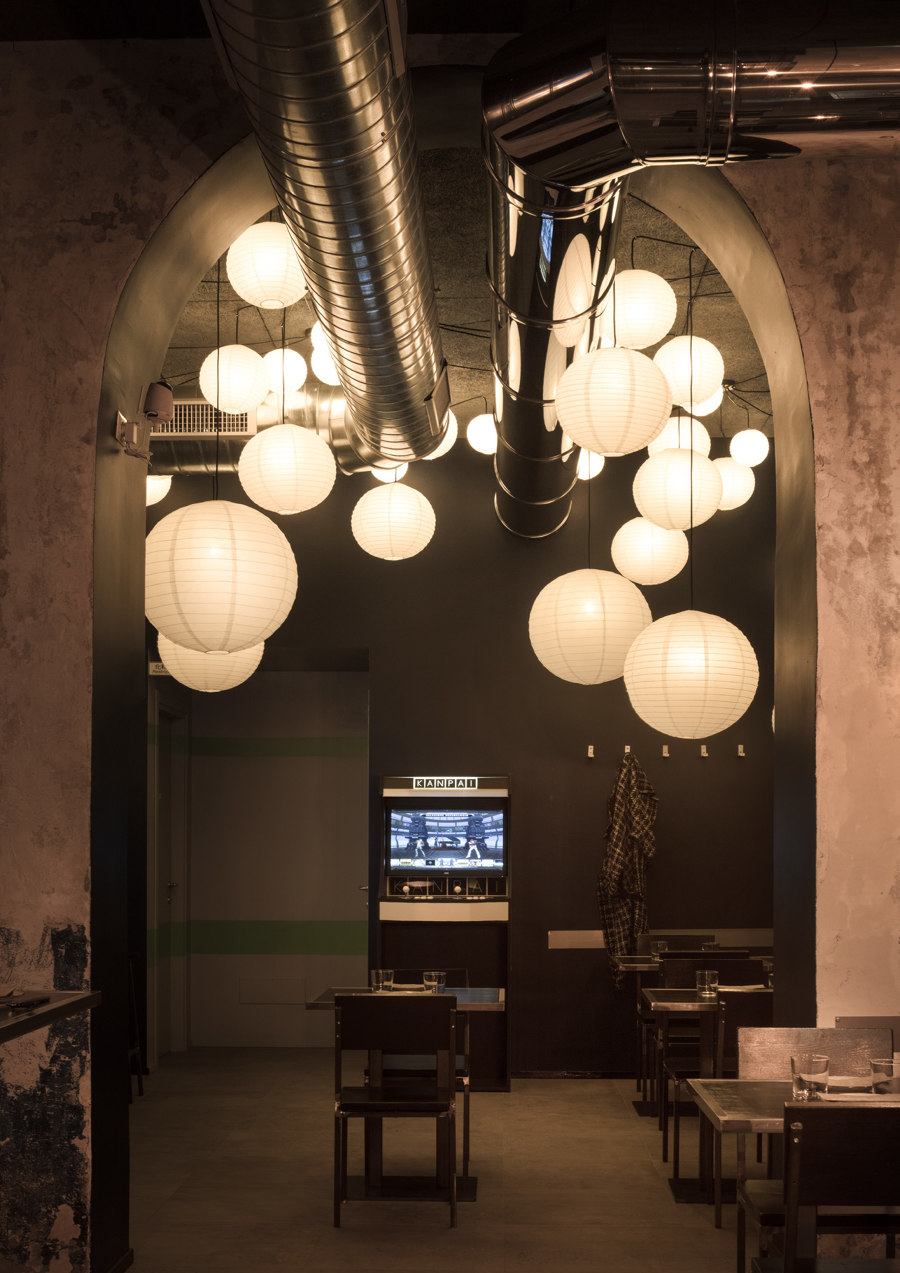Milan, Italy – A corner of contemporary Japan appears in the heart of Milan. Named Kanpai it proposes the Izakaya rites and atmosphere, accompanied by dishes from popular Japanese cuisine. Kanpai brings to Milan a mix of food, sakè and Japanese culture, no sushi and an oriental-style cocktail list: a place to eat and drink late into the night.
The interior design project is by the Milanese studio Vudafieri-Saverino Partners.
Kanpai affront the theme of popular memories which animate the post-work Tokyo evenings, setting as an objective to re-stitch an aesthetic relationship – narrative but not artificial – with Milan’s urban ambience in which Kanpai transports a sensation of contemporary Japan, recalling in a non vernacular way some of the typical elements of the traditional Izakaya.
In reality Kanpai could inhabit one of the many lively side streets in one of the Japanese metropolitan cities, with installed screens which transmit pop images typical of today’s technological, urban Japan. Open only in the evening, from 7.00 p.m. until late - the kitchen does not close before midnight - the project reassumes the passion for Japan of the 28-, 32- and 33-year old Italian business partners who have brought together food, culture and sakè, with the idea of presenting the most metropolitan image of Japanese cuisine: “not a stereotype of the traditional Japanese rice paper, but of what can be seen in Tokyo today, reconciling the local street soul tradition with an approach attentive to detail and to some gourmet proposals”.
The concept: interior design
Also in this project Vudafieri-Saverino Partners have treasured the pre-existing, tracing in the place’s markings and memories some of the elements around which to create the Kanpai atmosphere. Evident markings found in the walls’ irregularities and colours, left rough and enriched by partial decorative inserts. Essential furnishings, subdued lights, warm relaxing colours constitute the aesthetic score, never banal, in evoking Japanese culture. Kanpai’s 150 sqm are structured over three rooms, having diverse colour schemes and aesthetic atmospheres to interpret the different styles of conviviality and comfort.
The bar area welcomes customers with a large counter built with radical simplicity: the metal elements fuse with bamboo wood in a natural, geometric way, with a wide selection of sakè and spirits on show. At the centre a peculiar lampshade stands out, made from an antique French bottle rack used by wine makers to wash out the wine bottles. A kind of zinc-plated corset, into which magnums of sakè have been inserted, which become diffusers of light filtered by the bottles and the labels’ ideograms; an installation which celebrates the best of Japanese sakè.
In the second room a large mural by the young street artist Alessandro Di Vicino, in art Gaudio, has been painted, even visible from outside through the windows. The work – its pictorial part entirely realised by brushed acrylic paint – stems from the idea to represent the imaginary Japan that we have, and is in its fundamental part in the presence of the screens in which videos flash by: that of recreating Tokyo’s typical neon light street atmosphere. The Kanpai murals describe the sense of the contemporary through advertising clips, ghosts, programmes and sports events divided into three categories: EAT, DRINK and FUN.
Lastly the third room introduces blues shades, which render indefinite the perception of the depth and on which 50 Japanese lanterns have been left to float in shades of yellow and orange. A small cameo in the bathrooms, in which the atmosphere of the Yamanote Line has been reproduced, Tokyo’s famous circular Metropolitan line. Grey walls and double green stripes, photos which portray passengers squashed up against the windows, and the original stop announcer’s voice form a perfect Tokyo ambience. The Kanpai can be viewed in two ways; seen from a western eye, it could be interpreted as a piece of Tokyo arrived in Milan; while observed from a Japanese, it could appear as a western interpretation of Japan.
The cuisine philosophy
Japanese conviviality is expressed around the table, and every dish is the fruit of centuries of knowledge and heritage which are shared and passed on with pride and conviction. The Kanpai cuisine is part of this tradition: the desire to recreate in every recipe Japan’s most authentic spirit through a contemporary and innovative hand. The dishes are simple, yet at the same time the fruit of complex, never banal, techniques and preparation for recipes which have been reinvented for a more refined taste.
No sushi, and only one item dedicated to sashimi, the only raw dish on a menu which instead contemplates many different cooking techniques: fried chicken marinated in ginger (Karaage nanban lime), Kakuni (stewed pork belly), beef Tataki, pickled vegetables, black cod (marinated in miso cream for five days) and home-made side sauces. The Kanpai menu is the result of this mix: traditional affordable dishes expertly created by the Japanese chef Jun (ex-chef at the Gong restaurant), with many dishes to share together.
The Cocktail bar
Kanpai’s other soul is linked to the world of mixology and good drinking. Behind the bar we find Samuele Lissoni who creates an oriental-style drinks list. Many twists to the great mix classics, which line up next to his original creations for an experience to enjoy at the bar, from aperitif to after-dinner. Of interest, Mortal Kombu with tequila infused with kombu seaweed, orange curacao, liquid sugar, crushed ginger and tangerine air; or the Kanpai Highball with Nikka blended whisky, black cardamom syrup and bancha tea. Particular attention is paid to the world of sakè thanks to an accurate selection of many labels, but also to Japanese whisky and gin, alongside a wine list from small Italian and other wine producers.
Design Team:
Vudafieri-Saverino Partners: Tiziano Vudafieri, Claudio Saverino and Alice Brunello























